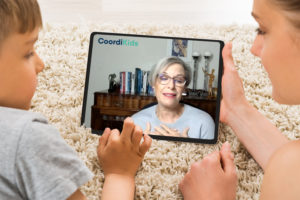ADHD & Attention Deficits, Dyspraxia / DCD, General Information, Sensory Processing
Occupational Therapy at Home
Many parents aren’t sure exactly what occupational therapy is and if you can do occupational therapy at home. Many of them have concerns as they observe their children growing at different paces than siblings or peers.
Not all children need occupational therapy, of course. But, did you know that occupational therapy isn’t just for children on the spectrum or those who have obvious developmental challenges?
There are so many benefits that all children can get from the types of therapy done in occupational therapy. At home support activities, such as those in the CoordiKids Home Courses, are growing in popularity among busy families and those who aren’t able to see their therapist in person.
So, how do you know if your child needs OT support?
A lot of times, there is a gut instinct from a parent who watches her child struggle in some way. A parent may ignore it for a long time, or even have doctors or teachers tell them not to worry about it.
Too often, I’m asked to see children that have been falling behind in school for years before someone finally took notice of specific red flags and suggested working with an occupational therapist.
Research from the National Institute of Child Health and Human Development has shown that brain plasticity decreases through childhood. It takes four times as long to intervene in fourth grade as it does in late kindergarten because of the process of brain development. It is also affected by the increase in content for students to learn as they grow older.
So, why not investigate as early as possible?
Let’s back up.
What is Occupational Therapy?
If an occupation is something that occupies your time, be it work or hobbies, then an occupational therapist is someone who works with an individual to get them functioning at their highest level in their occupation.
This might include helping people physically maneuver well enough to do their work, but it also includes their home life too: self-care, leisure, hobbies, hygiene.
People who don’t enjoy the full range of their physicality and mental capacity can be helped with occupational therapy. Most adults will become familiar with occupational therapy if they become injured or lose functionality due to serious illness.
Getting in and out of bed, working, taking care of things around the house, memory, driving – all are examples of how your “occupation” might be affected by a loss of function.
If a particular child is struggling due to gaps in development, he or she might struggle with motor skills, visual function, oral function (including speech and eating), memory, organization of the day (and of belongings!) and more.
Children facing developmental disabilities are likely to require occupational therapy to gain as much function as possible. Children who need additional help learning to walk and balance, use their fork and knife, speak clearly, or take care of themselves on a daily basis – these are just some of the children who often need intervention in the form of pediatric occupational therapy.
A child’s “occupation” can be anything from playing sport, learning in school, socializing with friends, or hobbies of any kind. That’s where pediatric occupational therapists step in!
What are Some Common Reasons a Child Might Start Occupational Therapy?
Some of the conditions that might require occupational therapy include:
- Autism
- Sensory Processing Disorder
- Dyspraxia or Development Coordination Disorder
- Difficulty eating, Picky eating disorder
- ADHD (attention deficit hyperactivity disorder) or an inability to sit still and focus during class
- Day-dreaming and poor awareness of body functions and environments
- Poor, illegible handwriting, poor fine motor skills
- Speech delays, difficulty with speech, oral motor challenges
ADHD and ADD, Sensory Processing Disorder, Dyspraxia and Autism Spectrum Disorder are all “hidden” conditions that affect everyday tasks but are often not recognized by their subtle symptoms.
Symptoms that can easily be disregarded as “he’s just being a rambunctious boy!” when your son obsessively rough-houses and wrestles with his friends.
Or “she’s just a day-dreamer” when your daughter seems to zone out from a project you’re doing together.
Some of the behaviors and symptoms that improve significantly with the correct intervention, include:
- Concentration & attention at school
- Fidgeting
- Distraction
- Handwriting
- Coordination & balance
- Social skills
- Athletics and sport
- Organization & Planning
- Following instructions
- Sitting still to complete a task
- Emotional outbursts
- Sensory seeking behaviors
- Sensory avoidance
How Do I Know if My Child Needs OT Support? At Home Evaluations are Worth Exploring
If you have concerns about sensory processing issues, you can start by taking our short online evaluation, or quiz. This quiz will ask you to rate your child’s abilities, developmental milestones, how he or she handles certain environmental and social situations, etc.
It will give you an automatic response based on your answers that will at least give you a base line understanding of your child’s challenges or if some of your concerns are not too worrisome for his or her age.
From there, the best thing to do is to have a consultation with your paediatritian as well as a paediatric occupational therapist. It will take a team of multidisciplinary experts in paediatric health, behavior, motor skill and sensory processing function to truly create a full picture of what interventions might help your child lead their best life, academically, socially, as well as their ability to function independently as an adult later in life.
I invite you to view our virtual consultation option, CoordiKids Consultation. You can set up a video chat through the fully secure and private Telehealth system with myself or any of the CoordiKids global team of practitioners.
If you have concerns about physical developmental milestones, fine motor skills or gross motor skills, take a look at this article that helps identify specific challenges in your child’s daily life.
Then, I would invite you to look out our CoordiKids Home Courses, which take children through a specific series of movements and exercises used in traditional occupational therapy.
At home support such as the structured courses that guide children through fun movement activities can make a huge improvement in specific challenges. Each fortnight introduces a new set of movements, building upon one another and following levels of neurological development and connection.
If you’re not sure if the program is suitable to your child, feel free to utilize a virtual consultation. You can set up a video chat through the fully secure and private Telehealth system with myself or any of the CoordiKids global team of practitioners.
If you have concerns about focus, attention, fidgeting and an inability to finish work, I would encourage you to look at our CoordiKids Classroom Course for your child to use throughout the day at school. These are 5-minute movement breaks that students can do in a group or alone in the back of the classroom or the gym to boost their attention span over the next learning block at school (or home school).
If you aren’t really sure what exactly it is that is triggering your concern, why don’t you view our virtual consultation. We are quite comfortable sitting down with your family “face-to-face” and just talking through your story and hearing what you need to express. We can talk just the two of us, or you can let your little one in on the call and I can have a chance to meet him or her, too!

How Does Occupational Therapy Work?
We use a combination of interventions and an understanding of neurology, neurodevelopment and sensory integration. We encourage development and growth of new pathways in the brain to coordinate movement, sensations, and attention span –helping individuals to function optimally in all areas of life.
Some of the therapy might seem a lot like physiotherapy. For example, we might ask clients to complete a series of physical exercises for strength and balance.
But the big difference between an occupational therapist and a physical therapist is that OTs measure progress by observing the client’s ability to complete certain daily tasks. Physical therapists observe the full range of movement of certain body parts to measure progress.
Most of the time, your child will complete a series of movements and therapeutic activities with their therapist during occupational therapy. At home, they are typically asked to continue to practice 15 minutes of the exercises on their own in order to see the greatest benefit.
Using Home Courses to Complement Therapy Sessions and to Reduce Costs
This is a great opportunity for me to explain a bit further about how the programs we’ve created at CoordiKids help people to gain the benefits of occupational therapy at home.
Traditionally, clients visit OTs in the office, sometimes several times per week. Each visit, we practice specific movements that have been scientifically shown to build and strengthen the neurological pathways affected by the client’s dysfunction. The movements build in complexity and physical difficulty from week to week.
However, it’s quite difficult for the modern family to get to regular therapy sessions.
Thanks to video telecommunication via Skype, Zoom, and Apple Facetime, they don’t always have to.
How can virtual developmental courses, like CoordiKids, be possible?
We’ve developed a virtual consultation system This allows us to speak with families around the world at the touch of a button. We are then able to devise a customized strategy for intervention among the team of OTs, dieticians, speech therapists, and even family counselors.
We’ve created revolutionary pediatric occupational therapy support options through CoordiKids Home Courses. The Home Course offers an opportunity for children to execute the common movements used for occupational therapy at home.
By putting my 40 years of experience to work, alongside my amazing team, we’ve put together a series of the most helpful, most commonly utilized physical exercises in pediatric occupational therapy.
At home courses, classroom courses, and preschool courses are based on neuroscience, sensory integration, research and other techniques to fill gaps in development, inhibiting optimal functioning. Children whose consultations determine them a good fit for these courses, can follow along with the series of videos in the comfort of their own home.
Some families choose to pair the virtual occupational therapy course with traditional office visits as a way to supplement or bridge office appointments. Others use a combination of virtual consultations and a CoordiKids Home course as their total pediatric OT program.
In this way, we are able to reach even the most remote families, from those deep in the Australian Outback to others as far as South Africa, the Great British Isles and the remotest areas in US.
I’m incredibly proud to say that I’ve helped so many families by creating a custom plan and following through with intervention, including step-by-step exercises to see real change. That’s what I’ve dedicated my life to, and that’s what my business, CoordiKids does.

Hello,
You misspelled the word “Coad” on your website. Sometimes errors like can hurt your web traffic. Maybe check out a service that alerts you to issues like SpellReport.com or CheckMySite.com.
-Robert
Hi Robert – this is the exact spelling of Lisa Coad’s surname – no misspelling
Pingback: Occupational therapy activities at home
Pingback: So what is ADHD?
Pingback: How Occupational Therapy improves the Lives of kids with ADHD & Autism
Pingback: Famous people with ADHD
Pingback: The Impact of Video-Based Exercises on Children with ADHD and Autism